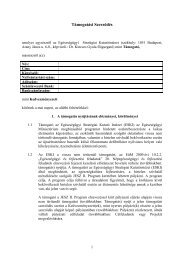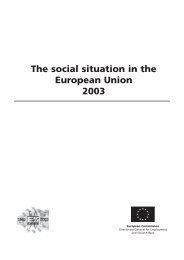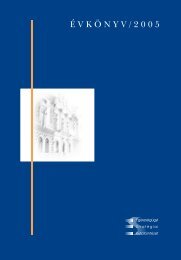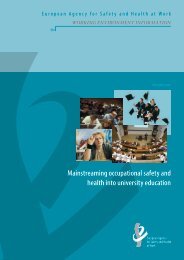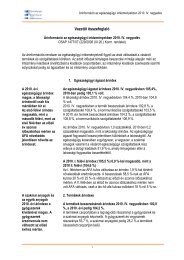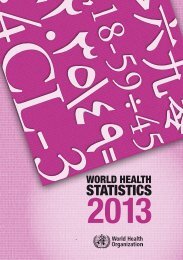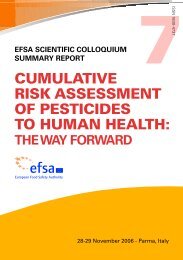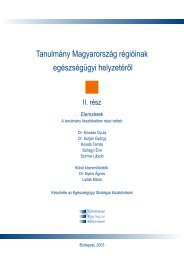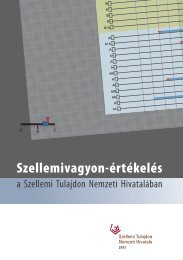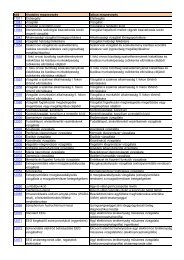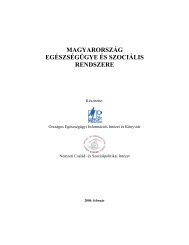Systematic review and evidence- based guidance ... - ECDC - Europa
Systematic review and evidence- based guidance ... - ECDC - Europa
Systematic review and evidence- based guidance ... - ECDC - Europa
You also want an ePaper? Increase the reach of your titles
YUMPU automatically turns print PDFs into web optimized ePapers that Google loves.
<strong>Systematic</strong> <strong>review</strong> <strong>and</strong> <strong>evidence</strong>-<strong>based</strong> <strong>guidance</strong> on perioperative antibiotic prophylaxisTECHNICAL REPORTObjective 3: What are the obstacles that prevent the implementation of adequatePAP?Five of the included studies analysed obstacles for compliance with the appropriate administration of PAP. One ofthese studies was already included in Objective 2. Details on distribution can be found in Table 6. Thecharacteristics of each study, the results <strong>and</strong> the grading of quality were summarised 8 .Table 6. Distribution of included study design <strong>and</strong> geographical location of included studies,Objective 3Type of studyDistribution (world regions)Observational cohort studies: n=3 (60%) North America: n=2Non-CBAs: n=1 (20%) Europe: n=2Questionnaire: n=1 (20%) Middle East: n=1Total: N=5A well-designed prospective cohort study by Al-Momany et al. enrolled 236 patients who were admitted for cardiacsurgery in the only official referral hospital for cardiac surgery in Jordan [85]. The investigators analysed theadherence to international PAP guidelines for cardiac surgery in their hospital. They demonstrated that adherenceto international guidelines for antibiotic selection was low (1.7%). It was also low with respect to dosage (27.9%)<strong>and</strong> duration (39.4%), whereas the adherence for timely administration of PAP was high at 99.1%. The authorsconcluded that the absence of st<strong>and</strong>ardised antimicrobial practice guidelines was responsible for a lack ofcommunication between anaesthesiologists <strong>and</strong> surgeons, thus producing poor monitoring <strong>and</strong> non-adherence.They proposed that hospital guidelines be developed <strong>and</strong> that the clinical pharmacist be given a central role inadministration, monitoring <strong>and</strong> intervention of PAP [85].Another well-designed study by Tan et al. reported on semi-structured interviews conducted withanaesthesiologists, surgeons <strong>and</strong> perioperative administrators in two large academic Canadian hospitals <strong>and</strong>highlighted workflow, unpredictable <strong>and</strong> unanticipated changes to the workflow, <strong>and</strong> role perception as thedominant obstacles in guideline observance [86]. Another important barrier to appropriate prescribing was the lowpriority assigned to timely antimicrobial administration, organisational communication, <strong>and</strong> inconvenience ofadministration.A prospective, multi-centre audit of 1763 elective procedures was performed in 13 Dutch hospitals (the study ispart of the PREZIES project) <strong>and</strong> published by van Kasteren et al. [87]. The objectives of this study were toanalyse the adherence to local hospital guidelines for PAP <strong>and</strong> explore the reasons for non-adherence. The studyidentified the following barriers: lack of awareness due to ineffective distribution of the most recent version of theguidelines, lack of agreement by surgeons with local hospital guidelines, <strong>and</strong> factors such as organisationalconstraints in the surgical suite <strong>and</strong> the ward.The study by Turnbull et al. identified same-day surgery <strong>and</strong> ß-lactam allergy as significant risk factors forinappropriate compliance with the proper timing of PAP [74].Although the non-CBA study by Brusaferro et al. had some serious limitations in respect to internal <strong>and</strong> externalvalidity, it provided interesting information about non-compliance [88]. In this study, a protocol for appropriatePAP was implemented <strong>and</strong> the reasons for non-compliance were investigated. The authors identified deficiencies inhospital policy, protocol definition, <strong>and</strong> cultural behaviour of healthcare workers as reasons for non-compliance.Summary of <strong>evidence</strong> for Objective 3: What are the obstacles that prevent the implementation ofadequate PAP?The following list summarises the obstacles or barriers for implementation of appropriate PAP:Absence of st<strong>and</strong>ardised local guidelines <strong>and</strong> lack of awareness of the most recent version of the guidelines[86,87]Workflow <strong>and</strong> organisational constraints [86-88]Disagreement with guidelines [86,87]Same-day surgery <strong>and</strong> ß-lactam allergy [74].Objective 4: Do selection, timing, dosage or duration of PAP as process indicatorshave an influence on the incidence of SSIs?A total of 44 studies were included. All evaluated the appropriate selection, timing <strong>and</strong> duration of PAPadministration <strong>and</strong> its association with SSI rates. Details on distribution can be found in Table 7.The characteristics of each study, results, <strong>and</strong> the grading of quality were summarised 8 .8 Further information is available upon request. See p. ii for details.18



